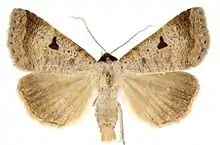Lygephila lusoria
Lygephila lusoria is a moth of the family Erebidae. The species was first described by Carl Linnaeus in his 1758 10th edition of Systema Naturae.[1] It is found in southern Europe, the Near East and Middle East, European south-eastern Russia, the Caucasus, Turkey and Israel.

Female Lygephila lusoria glycyrrhizae

Male Lygephila lusoria glycyrrhizae
| Lygephila lusoria | |
|---|---|
 | |
| Female Lygephila lusoria lusoria | |
 | |
| Male Lygephila lusoria lusoria | |
| Scientific classification | |
| Domain: | Eukaryota |
| Kingdom: | Animalia |
| Phylum: | Arthropoda |
| Class: | Insecta |
| Order: | Lepidoptera |
| Superfamily: | Noctuoidea |
| Family: | Erebidae |
| Genus: | Lygephila |
| Species: | L. lusoria |
| Binomial name | |
| Lygephila lusoria | |
| Synonyms | |
| |
There are two generations per year depending on the location. Adults are on wing from May to September.
The larvae feed on Vicia and Astragalus species.
Subspecies
- Lygephila lusoria lusoria
- Lygephila lusoria glycyrrhizae (Rambur, 1866) (Spain)
Lygephila amasina and Lygephila subpicata were previously treated as subspecies of Lygephila lusoria.
References
- Yu, Dicky Sick Ki. "Lygephila lusoria (Linnaeus 1758)". Home of Ichneumonoidea. Taxapad. Archived from the original on March 4, 2016.
External links
Wikimedia Commons has media related to Lygephila lusoria.
Wikispecies has information related to Lygephila lusoria.
- Fauna Europaea
- Lepiforum e.V. (in German)
- Kravchenko, V. D.; Müller, G.; Orlova, O. B.; Seplyarskaya, V. N. (2004). "The Catocalinae (Lepidoptera: Noctuidae) of Israel" (PDF). Russian Entomological Journal. 13 (3): 175–186. Archived from the original (PDF) on 2011-08-19 – via Internet Archive.
This article is issued from Wikipedia. The text is licensed under Creative Commons - Attribution - Sharealike. Additional terms may apply for the media files.